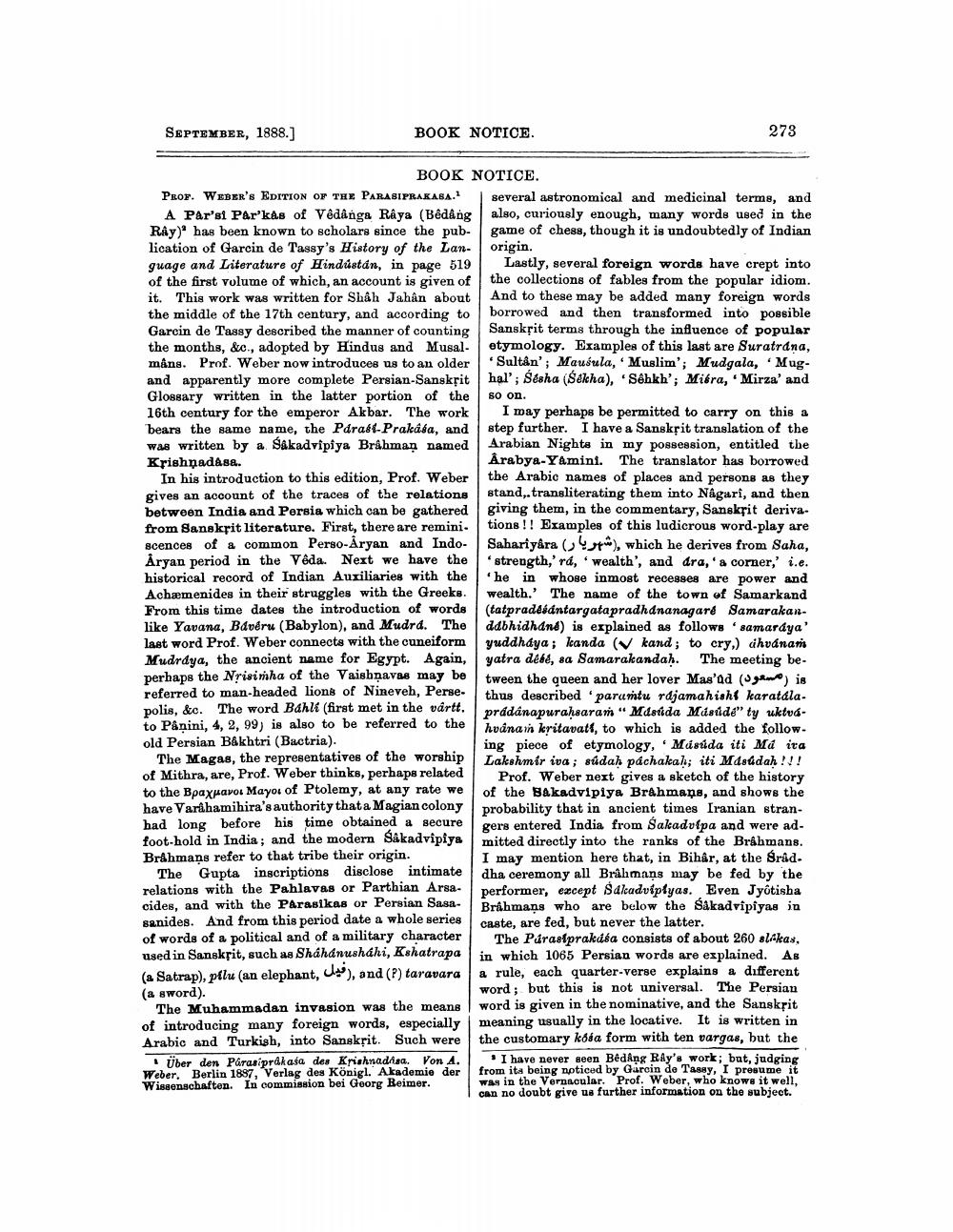________________
SEPTEMBER, 1888.]
BOOK NOTICE.
273
BOOK NOTICE. ProF. WEBER'S EDITION OF THE PARASIPRAKABA. several astronomical and medicinal terms, and
A Parisi Parkas of Vêdanga Raya (Bédang also, curiously enough, many words used in the Ray) has been known to scholars since the pub- game of chess, though it is undoubtedly of Indian lication of Garcin de Tassy's History of the Lan
origin. guage and Literature of Hindustan, in page 519 Lastly, several foreign words have crept into of the first volume of which, an account is given of the collections of fables from the popular idiom. it. This work was written for Shah Jahan about And to these may be added many foreign words the middle of the 17th century, and according to borrowed and then transformed into possible Garcin de Tassy described the manner of counting
Sanskrit terms through the influence of popular the months, &c., adopted by Hindus and Musal. etymology. Examples of this last are Suratrana, mång. Prof. Weber now introduces us to an older *Sultân'; Mausula, Muslim'; Mudgala, Mugand apparently more complete Persian-Sansksit hal'; Šésha (Sakha), Sébkh'; Miéra, Mirza' and Glossary written in the latter portion of the so on. 16th century for the emperor Akbar. The work I may perhaps be permitted to carry on this a bears the same name, the Pdraft-Prakába, and step further. I have a Sanskrit translation of the was written by a Sakadvipiya Brahman named Arabian Nights in my possession, entitled the Krishnadasa.
Årabya-Yamini. The translator has borrowed In his introduction to this edition, Prof. Weber the Arabic names of places and persons as they gives an account of the traces of the relations stand, transliterating them into Nagari, and then between India and Persia which can be gathered giving them, in the commentary, Sanskrit derivafrom Sanskrit literature. First, there are remini. tions !! Examples of this ludicrous word-play are scences of a common Perso-Aryan and Indo- Sahariyara (47), which he derives from Saha, Åryan period in the Veda. Next we have the strength,' rá, wealth', and dra,' a corner,' i.e. historical record of Indian Auxiliaries with the he in whose inmost recesses are power and Achæmenides in their struggles with the Greeks. wealth. The name of the town of Samarkand From this time dates the introduction of words (tatpraddidntargatapradhdnanagaré Samarakanlike Yavana, Bavéru (Babylon), and Mudrd. The I ddbhidhand) is explained as follows
ddbhidhdnd) is explained as follows 'samardya' last word Prof. Weber connects with the cuneiform yuddhaya; kanda (V kand; to cry,) chvánan Mudrdya, the ancient name for Egypt. Again, yatra débé, sa Samarakandah. The meeting beperhaps the Nrisinha of the Vaishnavas may be
tween the queen and her lover Mas'ud (Sgaw) is referred to man-headed lions of Nineveh, Perse.
thus described 'parumtu rdjamahish karatála. polis, &c. The word Bahut (first met in the vartt.
prddanapurahaarań" Mdstida Músúde" ty uktvato Pånini, 4, 2, 99) is also to be referred to the
hvána kritavati, to which is added the follow. old Persian Bakhtri (Bactria).
ing piece of etymology, Misuda iti Má ita The Magas, the representatives of the worship
Lakshmir iva; sudah pachakah; iti Mdsudah !!! of Mithra, are, Prof. Weber thinks, perhaps related
Prof. Weber next gives a sketch of the history to the Bpaxuavou Mayou of Ptolemy, at any rate we
of the Bakadvipiya Brahmans, and shows the have Varahamihira's authority that a Magian colony probability that in ancient times Iranian stranhad long before his time obtained a secure
gers entered India from Sakadvipa and were adfoot-hold in India, and the modern Sakadvipiysmitted directly into the ranks of the Brahmans. Brahmaņs refer to that tribe their origin.
I may mention here that, in Bihar, at the Srad. The Gupta ingcriptions disclose intimate dha ceremony all Brahmans may be fed by the
dha ceremony all Brahmane may he relations with the Pahlavas or Parthian Arsa
performer, except Sdleadviplyas. Even Jyotisha cides, and with the Parasikas or Persian Sasa
Brahmans who are below the Sakadvipiyas in sanides. And from this period date a whole series
caste, are fed, but never the latter. of words of a political and of a military character
The Paraslprakdea consists of about 260 slakas, used in Sanskrit, such as Shahanushahi, Kshatrapa in which 1065 Persian words are explained. As (a Satrap), pílu (an elephant, ux), and (P) taravara a rule, each quarter-verse explains a different (a sword).
word; but this is not universal. The Persian The Muhammadan invasion was the means word is given in the nominative, and the Sanskrit of introducing many foreign words, especially meaning usually in the locative. It is written in Arabic and Turkish, into Sanskrit. Such were the customary kósa form with ten vargas, but the
Über den Parasiprakasa des Krishnadisa. Von A. I have never seen Bedang Ray's work; but, judging Weber Berlin 1897, Verlag des Königl. Akademie der from its being noticed by Gurcin de Tassy. I presume it Wissenschaften. In commission bei Georg Beimer.
was in the Vernacular. Prof. Weber, who knows it well, can no doubt give ua further information on the subject.
al.




